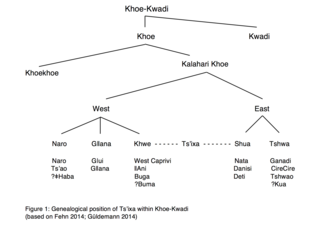Related Research Articles
Rapa Nui or Rapanui, also known as Pascuan or Pascuense, is an Eastern Polynesian language of the Austronesian language family. It is spoken on the island of Rapa Nui, also known as Easter Island.
Pukapukan is a Polynesian language that developed in isolation on the island of Pukapuka in the northern group of the Cook Islands. As a "Samoic Outlier" language with strong links to western Polynesia, Pukapukan is not closely related to any other languages of the Cook Islands, but does manifest substantial borrowing from some East Polynesian source in antiquity.
Vaeakau-Taumako is a Polynesian language spoken in some of the Reef Islands as well as in the Taumako Islands in the Temotu province of the Solomon Islands.
Taba is a Malayo-Polynesian language of the South Halmahera–West New Guinea group. It is spoken mostly on the islands of Makian, Kayoa and southern Halmahera in North Maluku province of Indonesia by about 20,000 people.
Futunan or Futunian is the Polynesian language spoken on Futuna. The term East-Futunan is also used to distinguish it from the related West Futunan (Futuna-Aniwan) spoken on the outlier islands of Futuna and Aniwa in Vanuatu.
Tamambo, or Malo, is an Oceanic language spoken by 4,000 people on Malo and nearby islands in Vanuatu.
Anejom̃ or Aneityum is an Oceanic language spoken by 900 people on Aneityum Island, Vanuatu. It is the only indigenous language of Aneityum.
Hoava is an Oceanic language spoken by 1000–1500 people on New Georgia Island, Solomon Islands. Speakers of Hoava are multilingual and usually also speak Roviana, Marovo, SI Pijin, English.
Ughele is an Oceanic language spoken by about 1200 people on Rendova Island, located in the Western Province of the Solomon Islands.
The Wuvulu-Aua language is spoken on Wuvulu and Aua Islands by speakers scattered around the Manus Province of Papua New Guinea. Although the Wuvulu-Aua language has a similar grammatical structure, word order, and tense to other Oceanic languages, it has an unusually complex morphology.

Iraqw is a Cushitic language spoken in Tanzania in the Arusha and Manyara Regions. It is expanding in numbers as the Iraqw people absorb neighbouring ethnic groups. The language has many Datooga loanwords, especially in poetic language. The Gorowa language to the south shares numerous similarities and is sometimes considered a dialect.
Papuan Malay or Irian Malay is a Malay-based creole language spoken in the Indonesian part of New Guinea. It emerged as a contact language among tribes in Indonesian New Guinea for trading and daily communication. Nowadays, it has a growing number of native speakers. More recently, the vernacular of Indonesian Papuans has been influenced by Standard Indonesian, the national standard dialect. It is mainly spoken in coastal areas of West Papua alongside 274 other languages spoken here.
Warndarang is an extinct Aboriginal Australian language in the Arnhem family, formerly spoken by the Warndarang people in southern Arnhem Land, along the Gulf of Carpentaria. The last speaker was Isaac Joshua, who died in 1974, while working with the linguist Jeffrey Heath.
Paresi is an Arawakan language spoken in Brazil. There are approximately 2000 Paresi people, and around 1800 speak the language. The Paresi live in the state of Mato Grosso, more specifically in nine indigenous territories: Rio Formoso, Utiariti, Estação Parecis, Estivadinho, Pareci, Juininha, Figueira, Ponte de Pedra, and Uirapuru. In terms of endangerment, it is not in immediate danger. It is used in many everyday domains, but there is a lack of transmission to younger generations, as well as an evident language shift to Portuguese. This is a result of Portuguese being used in education and healthcare, as well as the integration of Brazilian culture among the Paresi people, creating changes in their language and cultural practices.
Mavea is an Oceanic language spoken on Mavea Island in Vanuatu, off the eastern coast of Espiritu Santo. It belongs to the North–Central Vanuatu linkage of Southern Oceanic. The total population of the island is approximately 172, with only 34 fluent speakers of the Mavea language reported in 2008.
Tamashek or Tamasheq is a Malian variety of Tuareg, a Berber macro-language widely spoken by nomadic tribes across North Africa in Algeria, Mali, Niger, and Burkina Faso. Tamasheq is one of the three main varieties of Tuareg, the others being Tamajaq and Tamahaq.
Merei or Malmariv is an Oceanic language spoken in north central Espiritu Santo Island in Vanuatu.
Neve’ei, also known as Vinmavis, is an Oceanic language of central Malekula, Vanuatu. There are around 500 primary speakers of Neve’ei and about 750 speakers in total.
North Ambrym is a language of Ambrym Island, Vanuatu.

Tsʼixa is a critically endangered African language that belongs to the Kalahari Khoe branch of the Khoe-Kwadi language family. The Tsʼixa speech community consists of approximately 200 speakers who live in Namibia on the eastern edge of the Okavango Delta, in the small village of Mababe. They are a foraging society that consists of the ethnically diverse groups commonly subsumed under the sames "San", "Bushmen" or "Basarwa". The most common term of self-reference within the community is Xuukhoe or 'people left behind', a rather broad ethnonym roughly equaling San, which is also used by Khwe-speakers in Botswana. Atlhough the affiliation of Tsʼixa within the Khalari Khoe branch, as well as the genetic classification of the Khoisan languages in general, is still unclear, the Khoisan language scholar Tom Güldemann posits in a 2014 article the following genealogical relationships within Khoe-Kwadi, and argues for the status of Tsʼixa as a language in its own right. The language tree to the right presents a possible classification of Tsʼixa within Khoe-Kwadi:
References
- Capell, Arthur (1984). Futuna-Aniwa Dictionary, with Grammar Introduction . Pacific Linguistics, Australian National University. ISBN 0-85883-316-6.
- Dougherty, Janet W. D. (October 1983). West Futuna-Aniwa: An Introduction to a Polynesian Outlier Language. University of California publications in linguistics. University of California Press. ISBN 0-520-09657-6.
- Crowley, T., Lynch, J. and Ross, M., 2013. The Oceanic Languages. Hoboken: Taylor and Francis.